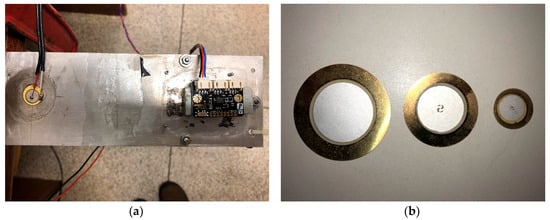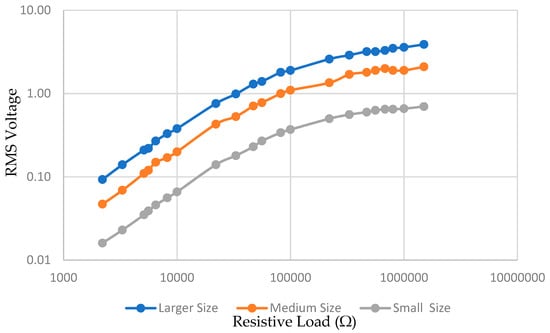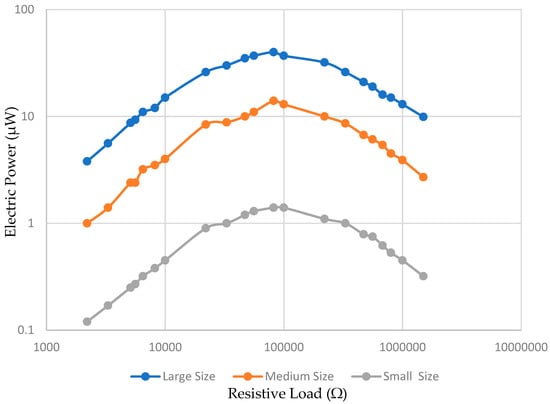Abstract
Energy harvesting engineering fields constitutes a promising area to provide electrical power for low-power electric applications obtained from other sources of energy available in the environment such as thermal, electromagnetic, vibrational and acoustic by using transducers. Vibrational sources stand out as a main alternative to be used for generating electric power in sensor nodes in microelectronic devices due to the greater energy conversion efficiency and the use of a simple structure. The cantilever is the main system implemented in studies of obtaining electric energy from vibrations using piezoelectric transducers. Most of piezoelectric transducers in the literature are not yet commercially available and/or are difficult to access for purchase and use. This paper proposes the characterization of low-cost piezoelectric transducers, configured as sensors, for Energy Harvesting applications using three different sizes of circular piezoelectric transducers (PZTs.) with diameters of 3.4 cm, 2.6 cm and 1.5 cm. For all three different PZTs, it was found that the maximum power transfer occurs for a resistive load of 82 kΏ. The maximum power generated in the load for the three PZTs was 40 uW, 14 uW and 1.4 W; with RMS voltages of 2.8 V, 2.10 V and 0.6 V; an acceleration of 1.3 g and a vibration frequency approximate of 7 Hz.
1. Introduction
Currently several applications such as wireless sensor networks and electronics embedded in clothing and biomedical devices such as pacemakers, require a high degree of electronic integration and low power consumption [1,2,3,4]. One way to extend the life of these electronic devices without battery replacements is to use transducers that can generate electricity from other sources of energy in the medium such as thermal, electromagnetic and mechanical (vibrational and acoustic) energy. This technique is known as Energy Harvesting. One of the main ways to generate electricity is piezoelectric energy harvesting, which uses a direct energy conversion from vibrations and mechanical deformation to the electrical energy. This source has shown to be promising in the generation of electrical energy in electronic devices such as sensor nodes and microelectronic devices due to higher energy conversion efficiency and the use of simple structure.
Different aspects of piezoelectric energy harvesting have attracted the attention of researchers. One of piezoelectric energy harvesting field front is to develop new composite material in order to achieve higher electric power generation [5,6,7,8]. Additionally, the performance of new beam and piezoelectric sensor forms for electric energy generation has been studied [9,10,11,12,13,14]. Despite these aspects, many practical issues such the high cost of piezoelectric transducers have limited their use in energy harvesting applications. Based on this issue, this work propose the characterization of low cost commercial piezoelectric transducers for energy harvesting applications. These type of transducers are commonly known as the piezoelectric diaphragms, which have similar characteristics to conventional lead zirconate titanate (PZT) ceramics and have been used in structure and electric power device monitoring [15,16,17].
The outline of this article is as follows: Section 2 presents the basics concepts of energy harvesting, piezoelectric transducers and the transducer used in this work. The experimental setup is described in Section 3, and then, in Section 4, the results are discussed. The conclusions of this paper are presented in Section 5.
2. Cantilever and Piezoelectric Sensor
Figure 1 shows a schematic of a cantilever structure compose by a beam fixed at one side, a tip mass fixed at free side and a piezoelectric sensor fixed near the fixed beam side. In our experiment, the system vibration is induced by a oscillating force generated (z-axis) by an eccentric motor fixed at the free beam side. As the motor voltage increase, the oscillation also increases and the beam vibrates at the excitation frequency. An accelerometer was fixed at the mass tip in order to measure acceleration and the mechanical energy.

Figure 1.
The cantilever schematic.
As the beam is fixed at one side and the free beam side oscillates, the beam and piezoelectric sensor deform (bend), generating an electric field [15,16,18]. The cantilever beam must oscillate at the resonance frequency in order to provide the higher diaphragm deformation and the consequent higher electric power that is generated. The piezoelectric diaphragms used in this work consist of a circular brass plate with a circular piezoelectric ceramic. The thickness of the plate and piezoceramic are 0.22 mm and the transducer element can vary between 9 mm to 25 mm [15].
3. Experimental Setup
Figure 2a shows our experimental cantilever setup and the three piezoelectric sensors with different sizes (Murata 7BB-12, 7BB-20 and 7BB27). The accelerometer and piezoelectric sensor signal acquisition were performed using a NI USB-6211 data acquisition (DAQ).

Figure 2.
The experimental Setup (a) and Piezoelectric sensors (b).
The weight of the beam, the tip mass plus motor was about 200 g. The beam’s dimension was 20 cm × 5 cm. Three different sizes of commercial piezoelectric sensors were tested (Figure 2b). A LabView program was developed to acquire and to show the accelerometer and piezoelectric sensor signals and also to calculate the electric power delivered to a resistive load.
4. Results and Discussion
We found a frequency resonance of 7.7 Hz and acceleration of 1.3 g (where g is the gravitational acceleration). Figure 3 shows the voltage generated for the three different piezoelectric sensors. The maximum output RMS voltages obtained were 2.9 V, 2.10 V and 0.6 V for the large, medium and small sizes, respectively. For all transducers sizes, we found the maximum power transfer to be 82 kΩ approximately (Figure 4). The maximum electric power measured at a load of 82 kΩ were 40 µW, 14 µW and 1.4 µW.

Figure 3.
The measurement results of RMS voltage.

Figure 4.
The measurement results of electric power.
For better comparison among the three PZTs sizes, Table 1 shows the power density per unity of area. At first glance one can see that by associating small PZTs in parallel, we can increase the total electric power generated. However, as one can see, the PZT large generates more electric power per area and, therefore, it is preferable to use large PZTs instead associate smaller PZTs.

Table 1.
The electric power density.
5. Conclusions
Piezoelectric energy harvesting is an important research field to develop alternative source power for low-power sensor networks and wearable electronic applications. In this work low-cost piezoelectric diaphragms were characterized for energy harvesting applications. Three different transducers size were performed generating 40 µW, 14 µW and 1.4 µW for the large, medium and small sizes respectively. We found density electric power values of 11.55 µW/cm2, 6.17 µW/cm2 and 2.20 µW/cm2 for the large, medium and small sizes, respectively, at a resonance frequency of 7.7 Hz. Although it is possible to associate several small sizes of this kind of diaphragm to achieve high electric power generation, we found that using the larger sizes of these transducers lead to a higher density of electric power generated. Therefore, for the same area available, a greater size of piezoelectric is preferable.
Author Contributions
All authors contributed in writing, proofreading, and providing suggestions for the improvement of the paper.
Conflicts of Interest
The authors declare no conflict of interest.
References
- Inman, D.J.; Erturk, A. Piezoelectric Energy Harvesting; John Wiley & Sons: Hoboken, NJ, USA, 2011. [Google Scholar]
- Beeby, S.; White, N. Energy Harvesting for Autonomous Systems; Artech House: Norwood, MA, USA, 2010. [Google Scholar]
- Priya, S.; Inman, D.J. Energy Harvesting Technologies; Springer: Berlin/Heidelberg, Germany, 2009; Volume 21. [Google Scholar]
- Roundy, S.; Wright, P.K.; Rabaey, J.M. Energy Scavenging for Wireless Sensor Networks; Springer: Berlin/Heidelberg, Germany, 2003. [Google Scholar]
- Khan, A.; Abas, Z.; Kim, H.S.; Oh, I.-K. Piezoelectric thin films review of transducers and energy harvesting. Smart Mater. Strut. 2016, 25, 1–16. [Google Scholar] [CrossRef]
- Caliò, R.; Rongala, U.B.; Camboni, D.; Milazzo, M.; Stefanini, C.; Petris, G.; Oddo, C.M. Piezoelectric energy harvesting solutions. Sensors 2014, 14, 4755–4790. [Google Scholar] [CrossRef] [PubMed]
- Uchino, K. The development of piezoelectric materials and the new perspective. In Advanced Piezoelectric Materials; Woodhead Publishing: Cambridge, UK, 2010; pp. 1–85. [Google Scholar]
- Zhang, S.; Li, F.; Jiang, X.; Kim, J.; Luo, J.; Geng, X. Advantages and challenges of relaxtor-PbTiO3 ferroelectric cristals for electroacoustic transducers—A review. Prog. Mater. Sci. 2015, 68, 1–66. [Google Scholar] [CrossRef] [PubMed]
- Dietl, J.M.; Garcia, E. Beam shape optimization for power harvesting. J. Intell. Mater. Syst. Struct. 2010, 21, 633–646. [Google Scholar] [CrossRef]
- Goldschmidtboeing, F.; Woias, P. Characterization of different beam shapes for piezoelectric nergy harvesting. J. Micromech. Microeng. 2008, 18, 1–7. [Google Scholar] [CrossRef]
- Ayed, S.B.; Abdelkefi, A.; Najar, F. Design and performance of variable-shaped piezoelectric energy harvesters. J. Intell. Mater. Syst. Struct. 2013, 25, 174–186. [Google Scholar] [CrossRef]
- Park, J.; Lee, S.; Kwak, B.M. Design optimization of piezoelectric energy harvester subject to tip excitation. J. Mech. Sci. Technol. 2012, 26, 137–143. [Google Scholar] [CrossRef]
- Rupp, C.J.; Evgrafov, A.; Maute, K. Design of a energy harvesting systems: A topology optimization approach based on multilayers plates and shell. J. Intell. Mater. Syst. Struct. 2009, 20, 1923–1939. [Google Scholar] [CrossRef]
- Yang, Z.; Wang, Y.Q.; Zuo, L.; Zu, J. Introducing arc-shape piezoelectric elements into energy harvesters. Energy Convers. Manag. 2017, 148, 260–266. [Google Scholar] [CrossRef]
- De Freitas, E.S.; Baptista, F.G.; Budoya, D.E.; de Castro, B.A. Equivalent circuit of piezoelectric diaphragms for impedance-based structural health monitoring applications. IEEE Sens. J. 2017, 17, 5537–5546. [Google Scholar] [CrossRef]
- Castro, B.A.; Clerice, G.A.; Andreoli, A.L.; de Souza Campos, F.; Ulson, J.A. A low cost system for acoustic monitoring of partial discharge in power transformer by Piezoelectric Sensor. IEEE Lat. Am. Trans. 2016, 7, 3225–3231. [Google Scholar] [CrossRef]
- Budoya, D.; Castro, B.D.; Campeiro, L.; Silveira, R.D.; Freitas, E.D.; Baptista, F. Analysis of Piezoelectric Diaphragms in Impedance-Based Damage Detection in Large Structures. Proceedings 2018, 2, 131. [Google Scholar]
- De Castro, B.A.; de Melo Brunini, D.; Baptista, F.G.; Andreoli, A.L.; Ulson, J.A. Assessment of macro fiber composite sensors for measurement of acoustic partial discharge signals in power transformers. IEEE Sens. J. 2017, 17, 6090–6099. [Google Scholar] [CrossRef]
© 2019 by the authors. Licensee MDPI, Basel, Switzerland. This article is an open access article distributed under the terms and conditions of the Creative Commons Attribution (CC BY) license (https://creativecommons.org/licenses/by/4.0/).